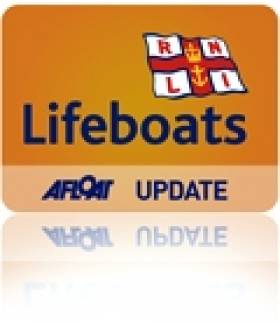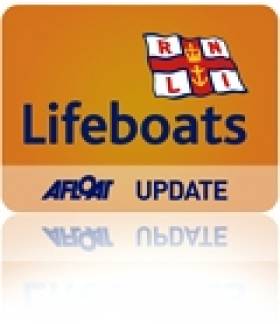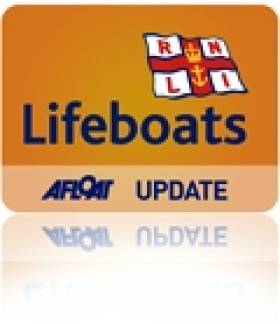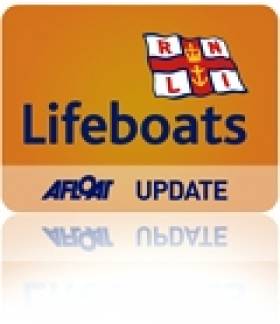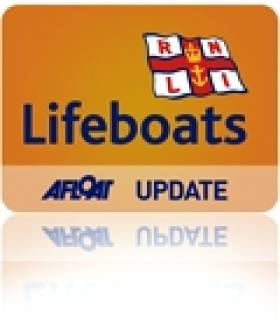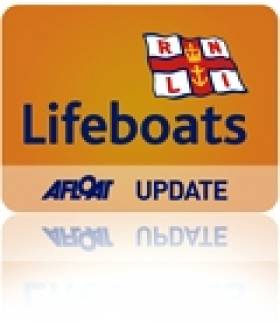Displaying items by tag: Lifeboats
Arklow RNLI Rescues Couple From Yacht With Fouled Propeller
#RNLI - Arklow RNLI rescued a man and woman after their 12m yacht got into difficulty of the Wicklow coast yesterday afternoon (Wednesday 19 June).
The volunteer crew was requested to launch their all-weather lifeboat at 12.23pm following a report that a vessel was in distress four miles north of Arklow.
The man and woman on board the stricken vessel had been travelling from Scotland and were Arklow-bound on their journey home to Kent when they got into difficulty. Weather at the time was good.
Arriving on scene, the crew on board the lifeboat Ger Tigchelaar - under coxswain Ned Dillon - assessed the situation and observed that the vessel’s propeller had been fouled.
The stricken yacht’s crew had made efforts to clear the fouled lines. A tow line was quickly established and the vessel was towed safely back to Arklow.
Speaking after the call-out, Arklow RNLI volunteer lifeboat press officer Mark Corcoran said: "The man and woman on board the yacht this afternoon came into the lifeboat station to express their appreciation to the crew who were delighted to assist and to be able to bring them and their vessel safely to shore."
Crew members on board the lifeboat included coxswain Ned Dillon, mechanic Michael Fitzgerald, Brendan Dillon, Roger Tyrell and Andy O’Loughlin.
Arklow RNLI Hosts Summer Solstice Fundraiser
#RNLI - Arklow RNLI supporters are being asked to come out and walk or jog a midnight mile - four laps of the running track at Coral Leisure Centre - in Arklow this Friday 21 June.
The walk/run will take place on the Summer Solstice from 10pm. The event is free and all donations are welcome. Prize raffles will take place, and Stormy Stan and his lifeboat buddies will be on hand to cheer on the participants.
Participants are being asked to assemble at the Lake Coffee Shop in the leisure centre from 10pm, with the walk/jog commencing just before midnight.
Full details are available from Mary at 086 304 5418.
In other Arklow RNLI news, a former chairman of fundraising at the lifeboat unit was honoured recently by the charity for his trojan work recently.
Tommy Annesley, a local councillor, received the Bronze Award at the recent RNLI Annual Presentation of Awards at Trinity College Dublin.
A few days later, Annesley was again honoured, this time by his hometown and fellow councillors when he became Lord Mayor of Arklow.
All at Arklow RNLI including lifeboat crew, fundraisers and other volunteers extended their best wishes to Tommy Annesley for his tenure as Lord Mayor.
Meanwhile, at the recent RNLI AGM in London, Arklow RNLI operations manager Jimmy Tyrell made a presentation to current RNLI operations director Mike Vlasto to honour the relationship and friendship that has developed between them in their years in the RNLI.
- A unique handcrafted piece was made locally in Arklow for the presentation.
Both Tyrell and Vlasto are retiring from the RNLI over the next year.
Portaferry RNLI Rescue Two Men In Drifting Dory
#RNLI - Portaferry RNLI launched on Saturday afternoon 15 June to go to the rescue of a small craft which had lost power in Strangford Lough, Co Down.
The volunteer lifeboat crew was alerted at 1.10pm following a call that there was a 5m Dory drifting after its engine had failed.
The lifeboat - helmed by Simon Rogers and with crew members George Toma, Brendan Byers and Ryan Kelly onboard - was launched at 1.20pm and was alongside the stricken vessel just off Gransha Point at 1.34pm.
The weather at the time was a slight swell, light winds and good visibility.
Once alongside, the lifeboat crew found that the Dory was taking on water. The two men were taken onboard the lifeboat and the Dory was towed into Strangford Lough Yacht Club where the men were also left off.
#Surfing - Two national broadcasters will base themselves in Bundoran this week ahead of the Sea Sessions Surf Music Festival at the weekend.
Today FM’s KC Show will broadcast live from the Bundoran RNLI Lifeboat Station tomorrow 19 June and Thursday 20 June, while 2FM will broadcast from the Sea Sessions from Friday 21 to Sunday 23 June, giving the seaside town unprecedented national media coverage for five days.
As part of a recent Discover Ireland promotion on Today FM, listeners were asked where to send the various shows to on their holidays. Listeners to the KC Show had a choice of sending him to Dingle or Donegal and following thousands of votes, Donegal came out on top.
One of the locations suggested was Bundoran, and the RNLI Lifeboat station at the pier was chosen as the home for the KC Show for two daily broadcasts this week complete with live musical guests Walking With Cars and new Irish act Daithi.
No sooner will Today FM have packed up than the 2FM Roadcaster will be rolling into the Main Beach car park and preparing to broadcast from the Sea Sessions on Friday, Saturday and Sunday.
The national state broadcaster will give the festival unprecedented coverage with over 20 hours scheduled live from the beachfront. Jenny Greene, Cormac Battle, Ruth Scott and Paddy McKenna will all host their shows live across the weekend.
Bundoran tourism officer Shane Smyth commented: "I am thrilled that not one but two national broadcasters will be in town this week. It will be a welcome boost to the ongoing promotion of Bundoran as a destination.
"Speaking as Bundoran RNLI volunteer lifeboat press officer also, I’m obviously delighted that the RNLI will benefit from two days of national coverage and I know that KC and his team are keen to find out more about the lifeboat service here in Bundoran."
Smyth added: "The guys from 2FM had a great time when they were here a few weeks ago and we look forward to welcoming them again over Sea Sessions weekend. Last time they were here they brought scorching sunshine with them – let’s hope they do the same again!”
Sea Sessions is Ireland's "biggest and best" surfing and music festival and returns for its sixth successive year in 2013. Based in Bundoran, the festival also includes surf tour events in Lahinch, Co Clare and nearby Sligo.
Galway Windsurfers Set Paddle Board Record
#Surfing - A trio of Galway windsurfers completed the 95km round trip to and from the Aran Islands last weekend - setting a new Irish record for stand-up paddle boarding in the process.
The Irish Times reports on the successful adventure by Dan Gardner, Daniel King and Joe Gallagher, who embarked on the challenge to raise funds for the Galway RNLI lifeboat service.
Setting out before 5.30am on the morning of Saturday 8 June, they returned to the Galway Docks before 11pm that night - stopping at the halfway mark for lunch on Inis Mór.
The trio are each believed to have covered some 4,000 strokes an hour to make their record time of 17 hours 33 minutes. The Irish Times has more on the story HERE.
In other surfing news, the Sunday Independent reports on a website that's seeking to connect surfers of all levels with the right waves for them.
Waterford-based Liam Sinnott set up Swellseekers.ie with business partner James Hassey two years ago, filling a gap in the market for booking surfing trips online at a time when Ireland was only just emerging as a world-class surfing destination.
Though the site currently only takes bookings for surfing and other watersports in the Waterford area, Sinnott says he hopes to expand his site's scope nationwide by next year to serve a growing wave-riding community of "50,000 surfing all year round".
Galway RNLI Rescues Man From Boat At Barna Rocks
#RNLI - Galway RNLI came to the rescue of a man whose 25ft sailboat almost hit rocks off Barna in Galway Bay on Sunday morning (9 June).
The alarm was raised by a member of the public who spotted the boat veering dangerously towards rocks south east of Barna Pier just before 11am. He contacted the Irish Coast Guard, who sought the assistance of Galway RNLI.
The volunteer lifeboat crew arrived at the scene at 11.14am and towed the sail boat out of difficulty. There was one person on board.
Galway RNLI lifeboat operations manager Mike Swan says with so many people on the water in this good weather, it's important that people be aware of the dangers in their local area.
The lifeboat crew on this call out were helmsman Declan Killilea, David Oliver, David Badger and Martin Oliver. Conditions were flat and calm.
Sligo Bay RNLI Celebrates 15th Anniversary This Weekend
#RNLI - Sligo Bay RNLI will celebrate its 15th anniversary this Sunday (16 June) with an open day at the lifeboat station in Rosses Point.
There will be an opportunity to chat to the crew, have a look around the station, visit the lifeboat shop and enjoy the seafaring music provided by the groups involved in the Sea Shanty Festival which is also taking place this weekend from 14-16 June.
Sligo Bay RNLI began life in a prefab cabin at Sligo Yacht Club back in 1998. Construction on the new lifeboat station situated at the pier in Rosses Point was completed in 2002. It houses a D Class lifeboat named Elsinore and has 22 volunteer crew members, along with a fundraising team and a lifeboat shop.
As part of the Sea Shanty Festival there will a gala concert in the Yeats Country Hotel on Saturday night (15 June), all proceeds from which will go the Sligo Bay lifeboat station. Tickets are available from the lifeboat station shop, Bay View Stores, Rosses Point and Source on John St in Sligo.
Elsewhere, RNLI volunteers and supporters from around Ireland were recognised for their role in supporting and raising funds and awareness for the lifesaving charity and its crews at the RNLI Annual Presentation of Awards in the Great Hall at Trinity College Dublin.
Guest of honour was the outgoing chairman of the RNLI, Admiral the Lord Boyce, who handed out awards to 51 volunteers throughout Ireland.
Irish Coast Guard director Chris Reynolds and his wife Geraldine along with Irish Water Safety CEO John Leech were also in attendance at the ceremony, presided over by the chairman of the RNLI Council of Ireland, John Coyle.
Awards presented on the day included two Gold Badges, four Silver Badges, 19 statuettes, 17 Bronze Badges, one pair of RNLI binoculars and eight Supporter Awards.
The Gold Badges were received by Jackie O’Grady from Clifden RNLI branch for his work over 25 years with the station, and to Hugh Stafford in Wexford for his role in the setting up of the Fethard-on-Sea lifeboat station in the early 1990s and his work since then in raising funds for the charity.
Also receiving an RNLI statuette was former lifeboat man at Rosslare Harbour, Fergus Wickham, who was recognised for almost five decades of volunteering with the RNLI, first as a lifeboat man and then as a launching authority at the station.
Crash With Turbine Caused Strangford Lough Yacht Dismasting
#RNLI - A collision with a tidal turbine was to blame for the incident that caused the dismasting of a yacht in Strangford Lough on Sunday 9 June.
As reported yesterday on Afloat.ie, Portaferry RNLI's lifeboat crew was dispatched to the stricken yacht in the narrows of Strangford Lough close to the SeaGen water turbine.
The local RNLI press office confirmed that three men and a teenage boy were on board the 37ft yacht at the time - though BBC News says that only three people were rescued, including a child.
The SeaGen installation in Strangford Lough was accredited by Ofgen as Britain's first tidal power plant, as previously reported on Afloat.ie.
#RNLI - Enniskillen RNLI today (10 June) brought four people to safety in two separate incidents on Lough Erne in Co Fermanagh.
In the first call-out of the day, the volunteer lifeboat crew retrieved a man and women from their stranded cruiser which had developed engine problems and run aground on Lower Lough Erne.
The inshore lifeboat Joseph and Mary Hiley and the Rescue Water Craft (RWC) were launched just before 10am at the request of Belfast Coastguard and made the 25-minute, six-mile journey to the casualty's last known position at Crunnish Island. The wind was coming from the south east, force five with good visibility.
On arrival at the scene, the crew noted the casualties had deployed their anchor and there were strong waves hitting the starboard side of the vessel.
The RWC crew member was transferred to the casualty vessel to reassure the crew and to check for any leakage. Another crew member from the lifeboat was transferred to assist with the tow and to lift the anchor.
The lifeboat established a tow and the vessel was refloated and brought to safety at Tudor Farm jetty, close to the initial location.
Less than three hours later, the inshore lifeboat Jason Logg was launched by request of Belfast Coastguard to rescue two people on a broken-down personal water craft on Upper Lough Erne.
The crew proceeded to the casualty's last known whereabouts at the mouth of Tamlagh Bay, four miles downstream from the station towards Enniskillen.
On arrival, the crew found the troubled vessel in the reeds with two people sitting on it. The crew transferred both passengers onto the lifeboat before setting up a tow and bringing the water craft back to Bellanaleck Marina.
Elsewhere in Northern Ireland, Portaferry RNLI brought three men and a teenage boy to safety yesterday afternoon after their yacht got into difficulty off Portaferry in Co Down.
The volunteer lifeboat crew was alerted just after noon following a mayday call that there was a demasted yacht in trouble on Strangford Lough.
The lifeboat was launched minutes later and was alongside the stricken vessel, a 37ft yacht located in the narrows of Strangford Lough, at 12.10pm. Weather at the time was good with clear visibility and a flat calm sea.
One of the four casualties, who had been thrown from the vessel, had been recovered by a fellow crew member and all four were on board the yacht when the lifeboat crew arrived on scene.
Alongside, there was difficulty recovering the vessel so the mast and sail were cut away. Once cut, the lifeboat proceeded to tow the yacht with it crew on board safely back to Strangford where it was tied to a mooring.
Two of the crew were conveyed to hospital while the other two were made comfortable on the shore.
Portaferry RNLI was requested to launch for a second time later this afternoon following a report that a swimmer had gone missing in Newtownards. The lifeboat having launched was subsequently stood down after the missing person was found safe and well.
Clifden RNLI Rescues Inishbofin Casualty
#RNLI - Clifden RNLI‘s Atlantic 75 lifeboat launched on Thursday afternoon 6 June in response to a coastguard request to assist in the transfer of a casualty from Inishbofin Island in Co Galway to the mainland.
A 61-year-old man, who was visiting the island, had sustained significant facial injuries following a fall from a bicycle. Clifden RNLI lifeboat helm James Mullen, a full-time paramedic, was able to assess the casualty’s injuries on arrival.
Having checked him over, he and the other voluntary crew members transported the man quickly and safely to Cleggan pier and an awaiting ambulance, which then transferred him to University College Hospital Galway for further treatment.
Mullen said of the launch: “I was glad to be available to assist on this callout to Inishbofin today. Our swift launch and recovery time is vital regarding our local islands, and while the casualty’s injuries were not life threatening, they were certainly serious enough to warrant urgent medical attention.”
Inishbofin Island is located five miles off the Connemara coast and is a popular summer holiday destination.
The Clifden RNLI lifeboats have undertaken many launches to and exercises around the island, including with the island’s main ferry. And as previously reported on Afloat.ie, the station was recently chosen to trial the new Mersey class all-weather lifebo


























